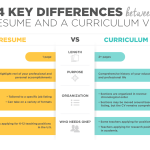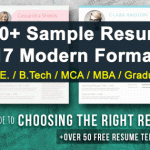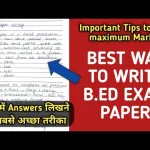When applying for jobs or academic positions, two primary documents often come into play: the Curriculum Vitae (CV) and the resume.
Both are used to showcase your qualifications, skills, and experiences, but they serve different purposes and are used in different contexts. Additionally, the term “Curriculum Vitae” (Latin for “course of life”) is sometimes used interchangeably with “CV,” which can cause confusion.
Here are complete detailed difference information
Curriculum Vitae (CV)
A Curriculum Vitae (CV) is a detailed document that provides an extensive overview of your educational and academic backgrounds as well as teaching and research experience, publications, presentations, awards, honors, affiliations, and other details of your academic career. A CV is typically used when applying for academic, education, scientific, medical, or research positions, and it can also be used when applying for fellowships or grants.
Resume
A resume is a concise document that summarizes your skills, experiences, and qualifications relevant to a specific job or industry. It is generally one to two pages long and is used in the private sector for job applications in business, industry, government, and non-profit sectors. A resume highlights your professional experience and is tailored to the job you are applying for.
Curriculum Vitae (The Latin Term)
The term “Curriculum Vitae” is Latin for “course of life.” In many non-English speaking countries, particularly in Europe, the term “Curriculum Vitae” (often shortened to CV) is used instead of “resume.” In these contexts, a CV generally refers to the same document as a resume in the United States and Canada.
Key Differences Between a CV and a Resume
- Length and Detail:
- CV: Often several pages long, as it includes comprehensive details about one’s academic and professional history.
- Resume: Typically one to two pages, focusing on relevant skills and experiences for a specific job.
- Purpose:
- CV: Used for academic, education, research, and scientific positions, as well as for applying to fellowships or grants.
- Resume: Used for job applications in most other industries, including business, industry, and non-profit sectors.
- Content:
- CV: Includes detailed sections such as education, teaching experience, research experience, publications, presentations, awards, honors, affiliations, and other academic achievements.
- Resume: Summarizes relevant work experience, skills, education, and certifications, often including sections like professional summary, work experience, skills, and education.
- Customization:
- CV: Generally remains constant, with updates to reflect new achievements and experiences.
- Resume: Tailored to each specific job application, highlighting the most relevant experiences and skills.
Detailed Breakdown of a CV and a Resume
Curriculum Vitae (CV) Example
Personal Information:
- Name: Dr. Jane Smith
- Address: 123 Academic Lane, City, State, ZIP Code
- Email: jane.smith@example.com
- Phone: (123) 456-7890
Education:
- Ph.D. in Molecular Biology, University of Research, 20XX
- M.S. in Biochemistry, University of Study, 20XX
- B.S. in Biology, University of Learning, 20XX
Research Experience:
- Postdoctoral Researcher, University of Research, 20XX-20XX
- Conducted research on gene expression in model organisms.
- Published findings in peer-reviewed journals.
- Graduate Research Assistant, University of Study, 20XX-20XX
- Investigated protein interactions in cellular pathways.
- Presented research at national conferences.
Teaching Experience:
- Lecturer, Department of Biology, University of Research, 20XX-20XX
- Taught undergraduate courses in molecular biology and genetics.
- Supervised laboratory sessions and student research projects.
- Teaching Assistant, University of Study, 20XX-20XX
- Assisted in teaching biochemistry and cell biology courses.
- Graded assignments and exams.
Publications:
- Smith, J., & Doe, J. (20XX). Title of Research Paper. Journal of Molecular Biology, 45(3), 123-145.
- Smith, J. (20XX). Title of Another Research Paper. Biochemical Journal, 78(2), 678-690.
Presentations:
- Smith, J. (20XX). Title of Presentation. National Conference on Molecular Biology.
- Smith, J. (20XX). Title of Another Presentation. International Symposium on Biochemistry.
Awards and Honors:
- Outstanding Research Award, University of Research, 20XX
- Graduate Fellowship, University of Study, 20XX-20XX
Affiliations:
- Member, American Society for Biochemistry and Molecular Biology
- Member, National Association of Biology Teachers
Skills:
- Molecular cloning
- Protein purification
- Fluorescence microscopy
- Data analysis with R and Python
Resume Example
Contact Information:
- Name: John Doe
- Address: 456 Professional Road, City, State, ZIP Code
- Email: john.doe@example.com
- Phone: (987) 654-3210
Professional Summary:
- Experienced marketing professional with over 8 years of experience in digital marketing, social media strategy, and content creation. Proven track record of increasing brand awareness and driving engagement through innovative campaigns.
Work Experience:
- Marketing Manager, Tech Innovators Inc., 20XX-Present
- Develop and implement comprehensive digital marketing strategies.
- Manage social media accounts and create engaging content.
- Analyze campaign performance and adjust strategies for optimal results.
- Digital Marketing Specialist, Creative Solutions LLC, 20XX-20XX
- Executed social media campaigns to increase brand visibility.
- Collaborated with design team to produce visual content.
- Conducted market research to identify trends and opportunities.
Skills:
- Digital marketing
- Social media management
- Content creation
- SEO and SEM
- Data analysis
- Adobe Creative Suite
Education:
- B.A. in Marketing, State University, 20XX
Certifications:
- Google Analytics Certified
- HubSpot Inbound Marketing Certification
Achievements:
- Increased social media engagement by 35% in one year at Tech Innovators Inc.
- Successfully launched a viral marketing campaign that resulted in a 50% increase in website traffic.
Detailed Comparison of Sections
Education
CV:
- Provides a detailed account of your academic background, including degrees, institutions, and dates of attendance.
- Lists relevant coursework, thesis/dissertation titles, and advisors (if applicable).
Resume:
- Summarizes your highest and most relevant degrees, usually including the institution and graduation date.
- Does not typically include detailed coursework or thesis/dissertation information.
Work Experience
CV:
- Focuses on academic, research, and teaching positions.
- Provides a thorough description of roles, responsibilities, and achievements.
Resume:
- Emphasizes professional experience relevant to the job you are applying for.
- Highlights key accomplishments and responsibilities in each role.
Skills
CV:
- Lists technical, research, and academic skills.
- May include languages, software proficiency, and laboratory techniques.
Resume:
- Focuses on skills pertinent to the job, such as technical abilities, soft skills, and certifications.
- Often formatted as a bulleted list for easy reading.
Publications and Presentations
CV:
- Includes a comprehensive list of all publications, such as journal articles, book chapters, and conference papers.
- Details presentations at conferences, seminars, and workshops.
Resume:
- Rarely includes publications and presentations unless they are highly relevant to the job.
Awards and Honors
CV:
- Lists academic awards, scholarships, fellowships, and other honors.
Resume:
- May include professional awards and recognitions that are relevant to the job.
Affiliations
CV:
- Lists memberships in academic and professional organizations.
Resume:
- Includes memberships in professional associations that are relevant to the job.
Formatting Differences
CV Formatting:
- Structured in a chronological format.
- Sections may include a detailed list of all relevant information.
- Length is not typically restricted; it can extend to several pages.
Resume Formatting:
- Structured in a reverse chronological or functional format.
- Information is concise and tailored to the job.
- Generally kept to one or two pages for brevity and clarity.
Geographic and Cultural Differences
The use and expectations of CVs and resumes can vary significantly by region and industry. Understanding these differences is crucial for effectively presenting your qualifications.
United States and Canada
In the United States and Canada, a resume is the standard document for job applications in most industries. A CV is used primarily for academic, research, and scientific positions.
Europe
In Europe, the term “Curriculum Vitae” (CV) is commonly used instead of “resume.” European CVs often include more personal information, such as date of birth and nationality, which would not typically be included in a U.S. resume due to anti-discrimination laws.
United Kingdom
In the UK, a CV is similar to a resume in the U.S. but may include more detailed sections, similar to an academic CV. It’s typically used for job applications across various industries.
Australia and New Zealand
In Australia and New Zealand, the terms CV and resume are used interchangeably, but a CV is generally longer and more detailed, while a resume is shorter and more tailored.
Asia
In many Asian countries, the terms CV and resume are used interchangeably, but the format and content can vary widely. In some countries, a photo and personal details such as marital status may be included, which is less common in Western countries.
Tailoring Your Document to the Job
Understanding the difference between a CV and a resume is essential for tailoring your application documents to the job or position you are applying for.
For Academic and Research Positions:
- Use a CV to provide a comprehensive overview of your academic achievements, research, and teaching experience.
- Highlight publications, presentations, and awards that demonstrate your expertise and contributions to your field.
For Industry and Professional Jobs:
- Use a resume to concisely summarize your relevant skills, experiences, and qualifications.
- Tailor the resume to the specific job by emphasizing the most relevant experiences and achievements.
Practical Tips for Creating Effective CVs and Resumes
- Be Clear and Concise:
- Use bullet points and clear headings to make your document easy to read.
- Avoid jargon and acronyms that may not be familiar to all readers.
- Use Action Verbs:
- Start bullet points with action verbs to convey your accomplishments effectively (e.g., “Managed,” “Developed,” “Conducted”).
- Quantify Achievements:
- Whenever possible, use numbers to quantify your achievements (e.g., “Increased sales by 20%,” “Published 5 research papers”).
- Proofread:
- Ensure there are no spelling or grammatical errors in your document.
- Consider having someone else review your document for a fresh perspective.
- Tailor to the Job:
- Customize your resume for each job application by highlighting the most relevant experiences and skills.
- For CVs, update them regularly to include new achievements and experiences.
In summary, while both a CV and a resume serve as tools to present your qualifications, they cater to different contexts and audiences. A CV provides an in-depth account of your academic and professional journey, ideal for positions in academia, research, and other scholarly pursuits. In contrast, a resume offers a succinct and targeted snapshot of your skills and experiences, tailored to specific job opportunities in the private sector. Understanding these distinctions and tailoring your application documents accordingly can significantly enhance your chances of securing the desired position. Whether you are crafting a detailed CV or a concise resume, the key is to present your achievements and skills in a clear, relevant, and compelling manner, ensuring that your qualifications stand out to potential employers
FAQ
1. What is a CV?
Answer: A CV, or Curriculum Vitae, is a detailed document that outlines an individual’s entire career history, including education, professional experience, skills, publications, and other accomplishments. It is typically used for academic, research, and education positions, as well as for applying to graduate school.
2. What is a Resume?
Answer: A resume is a concise document, usually one to two pages long, that summarizes an individual’s relevant work experience, skills, and education tailored for a specific job application. It is commonly used in the private sector and is more targeted to the job being applied for.
3. What are the main differences between a CV and a resume?
Answer:
- Length: A CV is longer and more detailed than a resume. A resume is typically one to two pages.
- Content: A CV includes a comprehensive history of academic and professional achievements. A resume includes only information pertinent to the specific job.
- Purpose: A CV is used primarily for academic, research, and educational applications. A resume is used for job applications in various industries.
- Customization: A resume is often tailored to each specific job application, while a CV remains static and is updated with new achievements.
4. What kind of information is included in a CV?
Answer: A CV typically includes:
- Contact Information
- Professional Summary or Objective
- Education
- Professional Experience
- Research Experience
- Publications
- Presentations
- Awards and Honors
- Professional Affiliations
- Skills
- References
5. What kind of information is included in a resume?
Answer: A resume typically includes:
- Contact Information
- Professional Summary or Objective
- Work Experience
- Education
- Skills
- Certifications (if applicable)
- Additional Sections (such as volunteer work, relevant projects, or interests)
6. When should you use a CV instead of a resume?
Answer: You should use a CV when applying for positions in academia, research, science, or education. It is also used when applying for graduate school or academic fellowships.
7. When should you use a resume instead of a CV?
Answer: You should use a resume when applying for jobs in the private sector, including business, technology, finance, marketing, and other industries where a concise summary of qualifications is preferred.
8. How is a CV formatted compared to a resume?
Answer: A CV is formatted in a detailed and structured manner, often with clearly defined sections such as Education, Research, Publications, etc. A resume is formatted for brevity and relevance, with a focus on making the document easy to read quickly.
9. Can you convert a CV into a resume?
Answer: Yes, you can convert a CV into a resume by condensing the information to focus on the most relevant skills and experiences for the job you are applying for, and by limiting the length to one or two pages.
10. Why is the length of a resume generally shorter than a CV?
Answer: The length of a resume is generally shorter to ensure that the information presented is concise and relevant to the specific job application, making it easier for employers to quickly assess an applicant’s qualifications.
Difference Between Curriculum Vitae and Resume
1. What does Curriculum Vitae (CV) mean?
Answer: Curriculum Vitae (CV) is a Latin term meaning “course of life,” and it is a detailed document covering an individual’s entire career, including educational background, professional experience, skills, and accomplishments.
2. What does Resume mean?
Answer: Resume is a French term meaning “summary,” and it is a brief document that highlights an individual’s relevant work experience, skills, and education for a specific job application.
3. How does the purpose of a CV differ from that of a resume?
Answer: The purpose of a CV is to provide a comprehensive history of one’s academic and professional background. The purpose of a resume is to present a brief and targeted overview of qualifications for a specific job.
4. What is the typical length of a CV?
Answer: The typical length of a CV can vary from 2 to multiple pages, depending on the individual’s experience and accomplishments.
5. What is the typical length of a resume?
Answer: The typical length of a resume is one to two pages.
6. Is a CV used globally the same way?
Answer: No, the usage of CVs varies globally. In the US and Canada, a CV is used mainly for academic, research, and education positions. In Europe, the term CV is often used interchangeably with resume and serves the same purpose as a resume in the US.
7. What details are usually omitted in a resume but included in a CV?
Answer: Details such as a comprehensive list of publications, presentations, detailed academic history, and professional memberships are usually included in a CV but omitted in a resume.
8. How frequently should a CV be updated?
Answer: A CV should be updated regularly, ideally every time there is a new accomplishment, publication, job change, or completion of significant projects.
9. How frequently should a resume be updated?
Answer: A resume should be updated before applying for a new job to ensure it reflects the most recent and relevant experiences and skills.
10. Which document (CV or resume) is more likely to include personal information such as date of birth and marital status?
Answer: A CV is more likely to include personal information such as date of birth and marital status, especially in countries outside the US where such details are commonly included.
Latest Posts
- Step-by-step guide to download and apply for jee mains admit card 202
- Comprehensive 2025 government holidays and recruitment details for job seekers
- JEE Mains Admit Card 2025: Your Step-by-Step Guide to Downloading the Hall Ticket
- Everything You Need to Know About 2025 Government Holidays Recruitment
- Comprehensive Guide to rrb d group recruitment 2025 – Eligibility, Vacancies, and Application
- Detailed guide to nps trust recruitment 2025 vacancies, eligibility and apply process
- Comprehensive guide to hpcl recruitment 2025 notification, vacancies, and application process
- ignou bed admission 2025 complete recruitment guide with eligibility and process
- Comprehensive Guide to Indian Army Agniveer Recruitment 2025 Notification and Jobs
- Everything You Must Know About CBSE Board Exams 2025 Changes & New Rules






